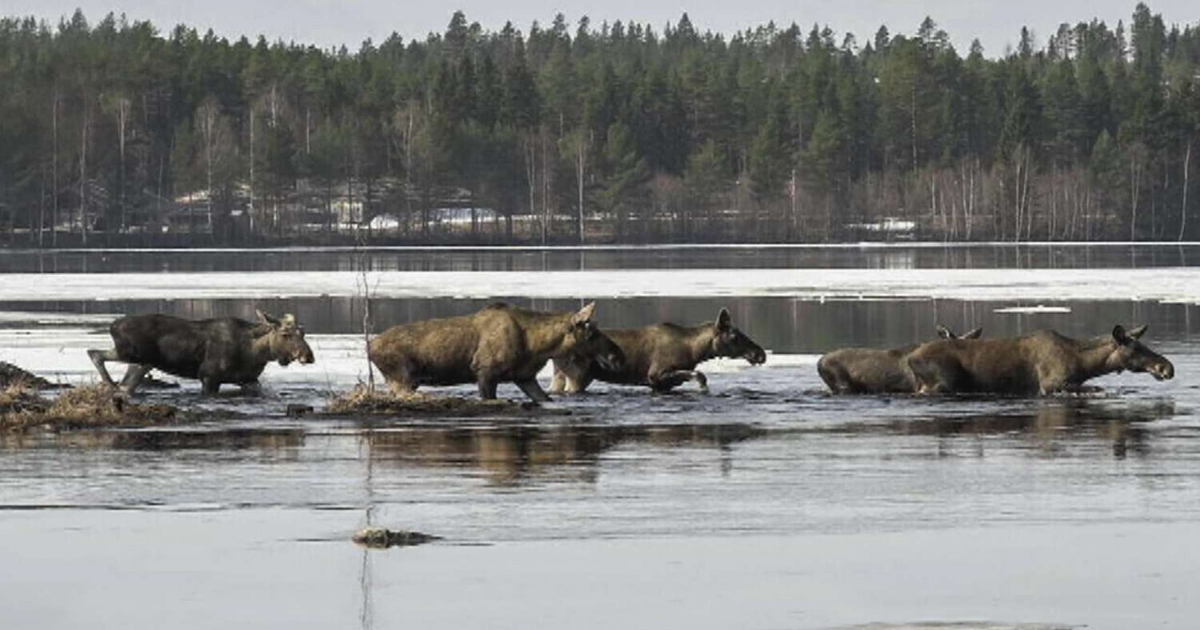Moose in Junsele, Sweden. Photo:
SVT via AP
- For years, Swedish broadcaster SVT has hosted The Great Moose Migration livestream
- The livestream provides 24/7 coverage of the 20-day migration of hundreds of moose through northern Sweden
- The Great Moose Migration gets millions of viewers each year, with many seeking out the livestream for relaxation
Sweden’s 24/7 TV coverage of the country’s epic moose migration has been gripping viewers around the world.
According to a press release from Visit Sweden, the livestream — Den stora älgvandringen, which translates to The Great Moose Migration — started on Tuesday, April 15, a week earlier than expected, thanks to an unusually early spring.
The first 24/7 livestream of the 20-day animal event began in 2019, with nearly a million people tuning in, according to the Associated Press. By 2024, the livestream had garnered a whopping nine million views on SVT Play, the streaming platform for Swedish broadcaster SVT, for the year.
The migration usually peaks in late April, but with temperatures rising across northern Sweden, the moose are already on the move. Their slow journey will see them migrate from coastal forests to higher inland pastures for summer, per the release.
Thirty-two cameras have been set up across the wilderness of the High Coast region to capture the animals’ movements, and millions have already tuned in to watch the moose slowly trudge through Sweden.
A photo captured by SVT during preparations for “The Great Moose Migration” livestream. SVT via AP
According to Today.com, crews use nearly 12 miles of cable to follow the moose on their migration path near the village of Kullberg in northern Sweden.
“For weeks, viewers can follow these quiet giants as they swim rivers, cross snowy trails, and occasionally stop to graze or nap in full view of the lens,” the release added.
Viewer William Garp Liljefors, 20, told AP of tuning in, “I feel relaxed, but at the same time I’m like, Oh, there’s a moose. Oh, what if there’s a moose? I can’t go to the toilet!”
“I was late to school because I saw moose and my teacher was like, ‘What, you saw moose in the city?’ And I was like, ‘No, it’s on the TV,'” he added.
Never miss a story — sign up for PEOPLE’s free daily newsletter to stay up-to-date on the best of what PEOPLE has to offer, from celebrity news to compelling human interest stories.
The show falls into the “Slow TV” genre, which involves watching uninterrupted footage of real-time experiences meant to be calming and immersive.
Johan Erhag, SVT’s project manager for The Great Moose Migration, also told the outlet that everyone who works on the show experiences a decrease in stress levels.
“We actually don’t see it [moose] very often. You often see it when you’re out driving, maybe once or twice in your life,” Erhag said. “I think that’s one thing why it has been so, so popular. And then you bring in the nature to everyone’s living room.”
According to the outlet, the moose migration crew, which can include up to 15 people, works out of SVT’s control room in Umeå, a city around 394 miles north of Stockholm. The team produces the show, which will run until May 4, at a distance so as not to interfere with the migration.
In 2024, 87 moose were spotted crossing the Ångerman River on camera — a highlight for viewers according to Today.com — up from 21 in 2023.
Other wildlife previously captured on the show, which features no narration or music, just nature, includes bears, reindeer, birds of prey, and otters.
The PEOPLE Puzzler crossword is here! How quickly can you solve it? Play now!
Sweden is home to an estimated 300,000 moose, according to the release.
The Great Moose Migration stream is available to watch at svtplay.se. According to the site, viewers should tune in during the dawn or dusk hours of northern Sweden for the best chance to see animals in action.
